Overview
Sumiyoshi Taisha has stood watch over Osaka Bay for almost 2,000 years. Founded by the legendary empress-regent Jingū in the third century, it honors four deities: a trio of sea gods called the Sumiyoshi Sanjin, and Empress Jingū herself, whose spirit was enshrined alongside them after her death.
Since its founding, Sumiyoshi Taisha has been linked with the sea. People involved in fishing, shipping, and other maritime industries still come to pray at Sumiyoshi for safe voyages. The shrine offers spiritual protection for the port of Osaka, which was the main gateway to Japan’s historical capitals and the rest of the country until the late nineteenth century.
Sumiyoshi Taisha has close ties with poetry, the performing arts, sumo wrestling, success in love and business, and the safe delivery of babies—a range that reflects the shrine’s long history and its place in the hearts of the people of Osaka, who affectionately call it “Sumiyossan.”
The shrine is famous throughout Japan for its rites and festivals. Two million people come to Sumiyoshi Taisha each January for hatsumōde, the traditional first shrine visit of the year. The midsummer Sumiyoshi Matsuri is one of Osaka’s biggest festivals, climaxing in a parade of portable shrines. Other events, such as ritual rice planting in June and a moon-viewing celebration in early autumn, attract visitors with music, dancing, and readings of traditional poetry.
History
Sumiyoshi Taisha spiritually protects the port of Osaka and the old imperial capitals of Nara and Kyoto further inland. In the nearly 2,000 years since it was founded, its devotees have included monarchs, poets, seafarers, traders, and millions of other people.
According to traditional histories, Sumiyoshi Taisha was established in 211 by empress-regent Jingū, who governed Japan after the death of her husband. Jingū dedicated the shrine to three gods of the sea, Sokotsutsuno-o no Mikoto, Nakatsutsuno-o no Mikoto, and Uwatsutsuno-o no Mikoto, who are collectively called the Sumiyoshi Sanjin. The names of these deities contain words meaning “bottom,” “middle,” and “surface,” suggesting that each had its own place in the depths of the sea. According to another theory, they also may represent the three bright stars of Orion’s belt, which were used by navigators. After empress-regent Jingū died, she was enshrined at Sumiyoshi as the deity Okinagatarashihime no Mikoto.
Sumiyoshi Taisha was built on the shores of Osaka Bay, but natural silt buildup and land reclamation slowly pushed the shoreline westward. Between the seventh and ninth centuries, Naniwa harbor near the shrine was the departure point for trade and diplomatic missions to the Asian mainland. Later, during the Edo period (1603–1867), the port of Osaka was the base for an important domestic trade route linking central Japan with communities on the Japan Sea coast.
Over the years, the focus of worship at Sumiyoshi Taisha has expanded beyond the original maritime gods. The shrine is associated with poetry, the performing arts, sumo wrestling, and success in business and love. “Sumiyossan,” as Osaka residents affectionately call it, appears in many Japanese stories—from ancient folktales to modern literature. A memorial on the grounds honors Kawabata Yasunari (1899–1972), the Nobel Prize–winning author who set a short story at the shrine.
The main buildings at Sumiyoshi Taisha are distinguished by their simplicity. Their straight-edged gable roofs and other features pre-date the arrival of more elaborate architectural influences from the Asian mainland. The style is called sumiyoshi-zukuri and became a model for shrine builders elsewhere in Japan.
Originally, Sumiyoshi Taisha’s four main shrines were rebuilt every 20 years. The practice was interrupted by civil war in the sixteenth century and was abandoned entirely in the early nineteenth. The current four main sanctuaries of the shrine were built in 1810 and are designated as National Treasures. Many of the other structures in the shrine grounds—including the stone stage completed in the early seventeenth-century—are designated Important Cultural Properties.
Precinct map
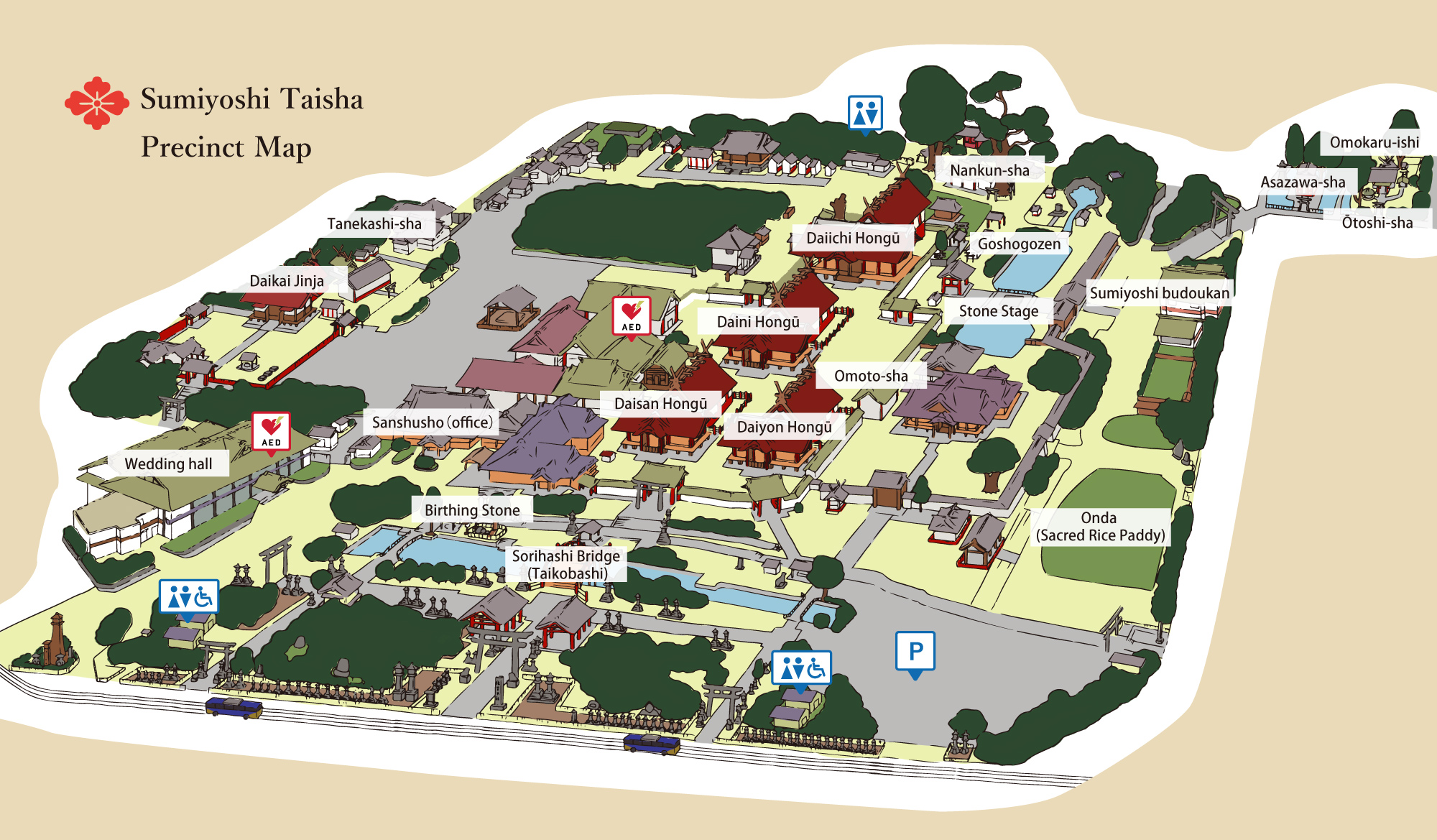
 Daiichi Hongo
Daiichi Hongo
(First main shrine) Nankun-sha
Nankun-sha
(Subsidiary shrine) Sorihashi Bridge
Sorihashi Bridge
(The arched bridge) Tanekashi-sha
Tanekashi-sha
(Subsidiary shrine) Omoto-sha
Omoto-sha
(Subsidiary shrine) Goshogozen
Goshogozen
(Sanctuary) Omokaru-ishi
Omokaru-ishi
(Fortune telling stones) Daikai Jinja
Daikai Jinja
(Subsidiary shrine) Ishibutai
Ishibutai
(Stone Stage) Onda
Onda
(Sacred Rice Paddy) Asazawa-sha
Asazawa-sha
(Subsidiary shrine) Ōtoshi-sha
Ōtoshi-sha
(Subsidiary shrine)
Location
2-9-89
Sumiyoshi, Sumiyoshi-ku, Osaka 558-0045
TEL : +81-6-6672-0753
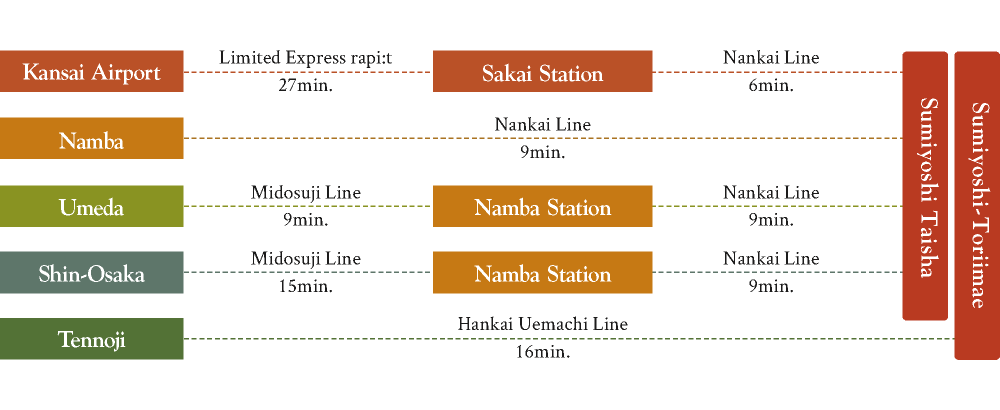
Nankun-sha
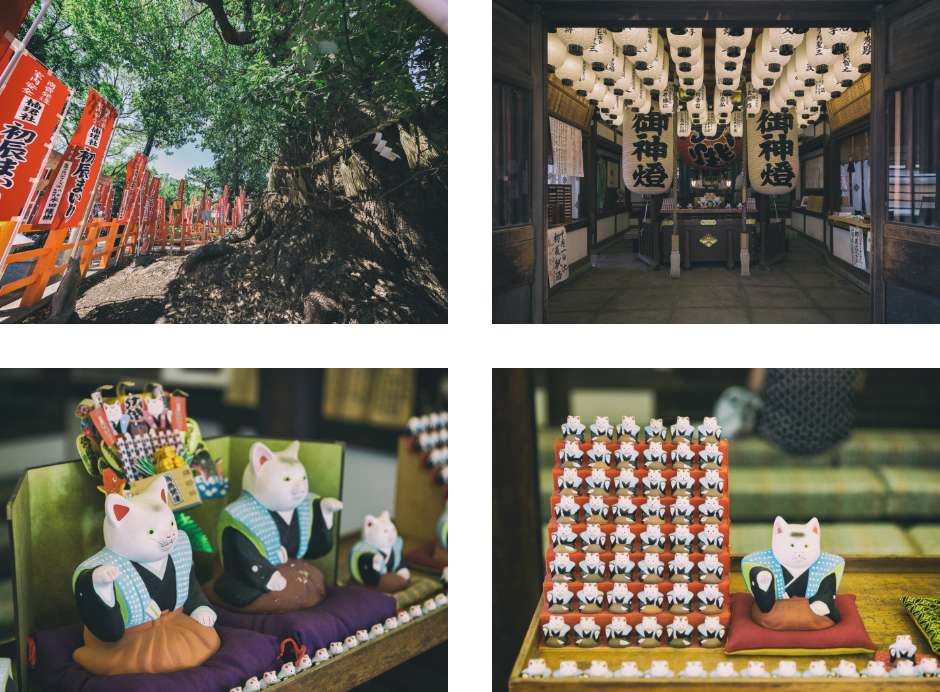
Nankun-sha
Nankun-sha is the second stop in the Hattatsu Mairi.
Hattatsu Mairi hours: 6:00 a.m. to 3:45 p.m.
Prayer donation: 1,500 yen
Nankun-sha is devoted to Uka no Mitama no Mikoto, a deity of grain and agriculture and a manifestation of the god Inari. As the second stop of the Hattatsu Mairi, Nankun-sha is associated with the dedication and hard work required to run a business. Visitors performing the more complex Minori Mairi rite can exchange the sacred rice seed for a stalk of rice here; the rice stalk can be exchanged again at the next shrine, Ōtoshi-sha.
Clay figurines of beckoning cats called shōfuku neko are available at Nankun-sha for visitors performing the Hattatsu Mairi. The prosperity-bringing charms come in two types. Cats with the left paw raised are said to attract customers to businesses that display them and are offered during odd-numbered months of the year. Cats with the right paw raised are said to bring financial wealth; they are available in even-numbered months.
Sorihashi Bridge
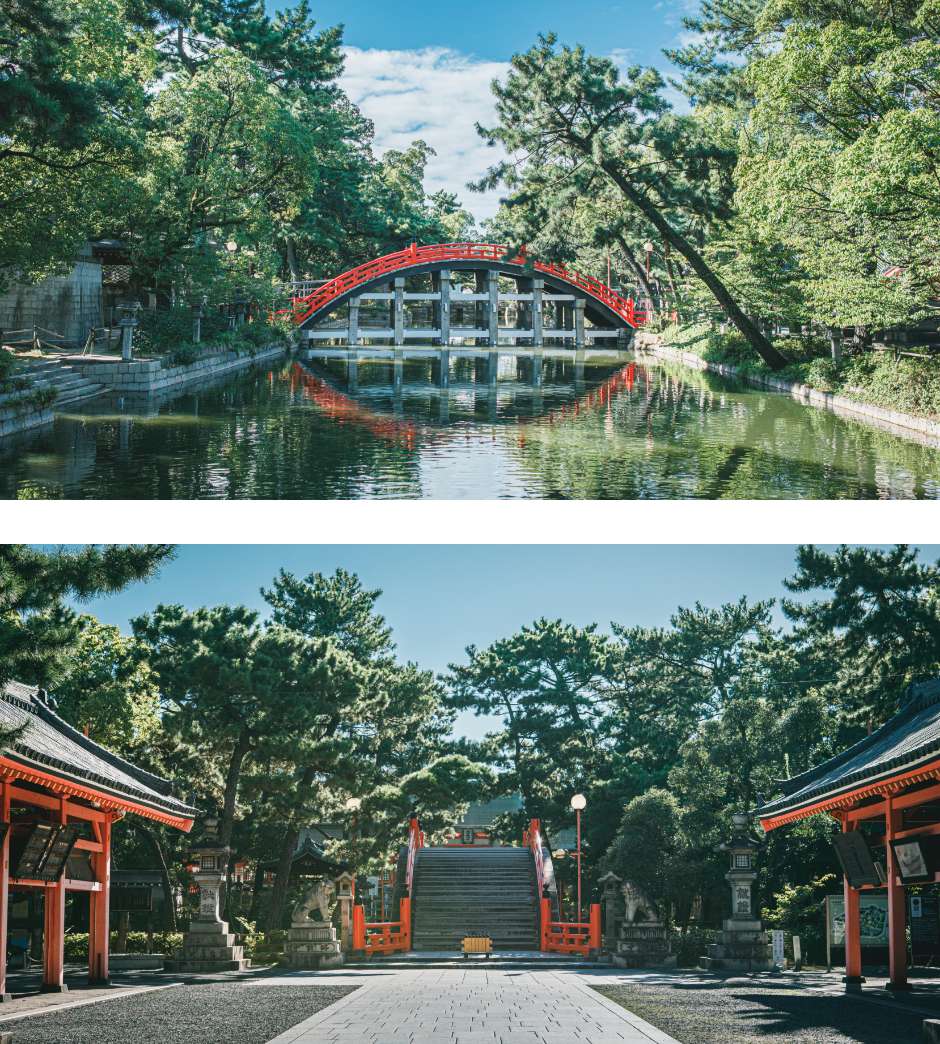
Sorihashi Bridge
The official name of this steeply curved bridge is Sorihashi, or “arched bridge,” but the structure is often called Taikobashi, or “drum bridge,” after the shape created by its reflection in the water below. According to popular tradition, crossing the bridge is an act of spiritual purification.
The shape of the bridge may have been inspired by rainbows, which connect the earth to the heavens. In Shinto mythology, the deities Izanagi and Izanami created the Japanese archipelago by stirring the sea with a rod while standing on a floating rainbow bridge. Izanagi is the “father” of Sumiyoshi Taisha’s patron deities: they came into being when he purified himself in the sea after a voyage to the underworld.
Although there are records of a bridge here since the thirteenth century, the bridge in its current form was built around 1600 with funds donated by Yododono (1567–1615). Yododono was a consort of Toyotomi Hideyoshi (1536–1598), the powerful warlord who re-unified Japan after a period of civil war and ruled from 1582 to 1598. Yododono was seeking the gods’ favor for her son Toyotomi Hideyori (1593–1615), who was at war with Tokugawa Ieyasu (1543–1616), founder of the Tokugawa shogunate (1603–1868).
The first arched bridge is believed to have been constructed by shipwrights, and shipbuilders have played a leading role in maintaining the structure ever since. It has been rebuilt and repaired numerous times. Before the steps were added in 1955, the only footholds were the gaps between the wooden slats, open to the water.
The modern bridge has a steel frame and cypress-wood boards. It is approximately 21 meters long, 5 meters tall, and 6 meters wide, with a slope of more than 40 degrees at its steepest point. The metalwork on the bridge’s railings has been preserved since the Edo period (1603–1867).
Nobel Prize–winning author Kawabata Yasunari (1899–1972) made the bridge famous in his short story that bears its name. “Sorihashi” is narrated by a man recalling a childhood incident in which his mother revealed a painful secret to him at the top of the bridge. The narrator tells the reader that descending the slope on the far side with his illusions shattered was more frightening than the initial climb.
Tanekashi-sha
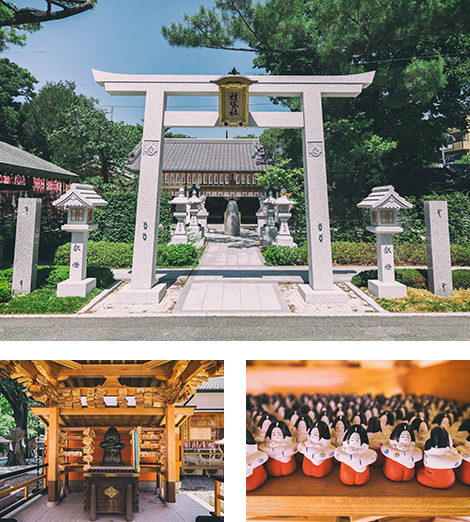
Tanekashi-sha
Tanekashi-sha is the first stop in the Hattatsu Mairi.
Hattatsu Mairi hours: 6:00 a.m. to 3:30 p.m.
Prayer donation: 1,100 yen
As the first stop in the Hattatsu Mairi ritual, Tanekashi-sha is associated with the investment and effort needed when starting up a successful business. Visitors performing the more complex Minori Mairi rite can buy a sacred rice seed from the shrine for 800 yen, which can be exchanged for a rice stalk at the next shrine, Nankun-sha.
Uka no Mitama no Mikoto is enshrined at Tanekashi-sha. The deity is one of the many forms of Inari, a Shinto deity of grain and agriculture. The shrine is associated with sowing and fertility (tane means “seed”). It is popular with people seeking to conceive children.
Omoto-sha
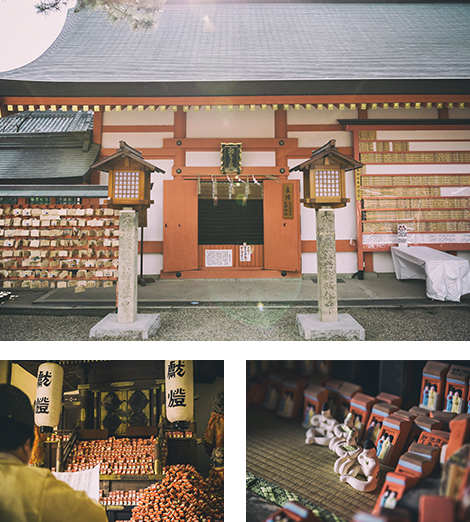
Omoto-sha
Tamomi no Sukune was the first head priest of Sumiyoshi Taisha. Empress-regent Jingū entrusted him with the building of the first Sumiyoshi shrine at the beginning of the third century after she had a vision of the three deities called the Sumiyoshi Sanjin.
Omoto-sha is a small shrine representing the devotion of Tamomi no Sukune and his wife Ichihime no Mikoto to the deities and each other. It is inside the building used to prepare food offerings for the Sumiyoshi Sanjin and Jingū. Omoto means “attendant” and refers to Tamomi no Sukune’s role as a servant of the deities.
Today, the shrine is frequented by people looking for love or wanting spiritual support in their romantic relationships. Visitors may purchase small wooden plaques (ema), write down their prayers and wishes for love, and hang the plaques up outside the shrine to be fulfilled by Tamomi no Sukune and Ichihime no Mikoto. There are two kinds of clay charm associated with Omoto-sha available at Sumiyoshi Taisha. One, called a hadaka bina, depicts a naked man and woman. It is thought to represent an ideal marital relationship in which the couple has no secrets. The other is called omoto ningyō and depicts a husband and wife in classical dress. It is thought to ensure happy relationships.
Goshogozen
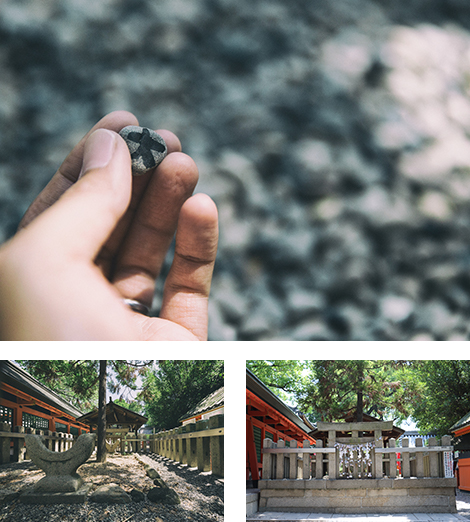
Goshogozen
More than 1,800 years ago, the legendary empress-regent Jingū is said to have encountered the three deities of Sumiyoshi Taisha in Kyushu. After the meeting, she traveled around western Japan looking for a place suitable to build a shrine to them. When she arrived at this spot, the three deities descended from a tree growing here. Empress-regent Jingū ordered the construction of a shrine around the tree. Upon her death, she, too, was enshrined as a deity at Sumiyoshi Taisha.
The go in Goshogozen, meaning “five,” refers to five kinds of blessings that are conferred by the deities: health, wisdom, wealth, happiness, and longevity. Pebbles inscribed with the character for “five” (go, 五), “large” (dai, 大), or “power” (riki, 力) are scattered among unmarked stones at the site. Anyone who finds one of each can take them home. A set of stones is believed to help make wishes come true. If a wish is fulfilled, the custom is to return the stones to Goshogozen, along with another set of three stones from the person’s home that are inscribed with the go-dai-riki characters. Symbolically, the believer is giving back twice what was received.
Fortune-Telling Stones: Omokaru-ishi
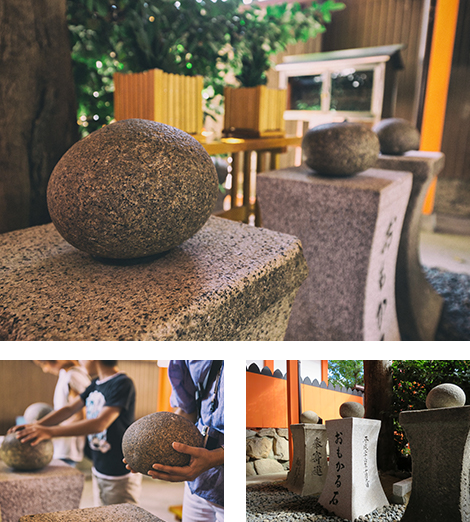
Fortune-Telling Stones: Omokaru-ishi
These stones are called the Omokaru-ishi. They are used for fortune-telling, specifically to check if a wish or goal will come true.
To perform the ritual:
1.Facing the shrine, bow twice, clap twice, then bow a final time.
2.Choose any one of the three stones.
3.Lift the stone, feel its weight, then put it back down.
4.Make a wish or think about a personal goal.
5.Lift the same stone again.
Did the stone feel lighter or heavier the second time around? According to tradition, if it felt lighter, your wish will come true. If it felt heavier, keep working at it, and maybe your wish will come true in the future.
Main Shrines (Hongū)
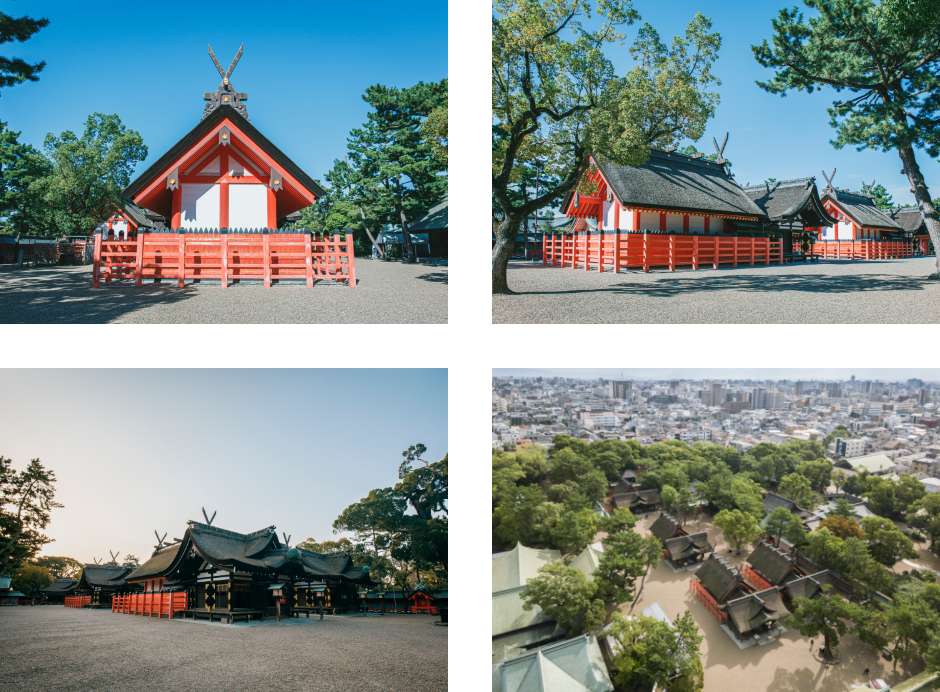
Main Shrines (Hongū)
The four main shrines, or hongū, at the heart of Sumiyoshi Taisha are home to the shrine’s patron deities: the three sea gods called the Sumiyoshi Sanjin and empress-regent Jingū, who is said to have founded the shrine in the third century. The main shrines were originally dismantled and rebuilt every 20 years, but this practice was disrupted by civil war in the sixteenth century and abandoned entirely in the early nineteenth. The current structures date from 1810.
The three hongū shrines dedicated to the Sumiyoshi Sanjin stand in a straight line along an east-west axis. This sets them apart from most Japanese shrines, which face south or east, following rules of geomancy adopted from China. According to one theory, the unique layout of the main shrines emulates the three stars of Orion’s belt, which were commonly used by navigators. The bright central stars of the Orion constellation cross the sky each night, rising in the east and setting in the west.
The shrine dedicated to empress-regent Jingū sits next to the westernmost Sumiyoshi Sanjin shrine. Its design mirrors that of the others except for one detail: the ends of the crossed timbers at either end of its roof ridge are cut horizontally rather than vertically—an acknowledgement, perhaps, of its occupant’s gender.
Each hongū consists of a main sanctuary called a honden, an attached offering hall called a heiden, and a corridor that connects the two called a watariden. The honden, in which the deity is enshrined, has two rooms. Its outer doors are opened for major rites and festivals, but the doors to the innermost sanctuary are kept closed; except for one special ceremony every 20 years.
The honden are built in the sumiyoshi-zukuri style, which pre-dates influences from the Asian mainland. The design is thought to be similar to the temporary shrines erected for the enthronement ceremonies of Japanese emperors during the Asuka period (592–710). The buildings are surrounded by wooden fences that delineate the sacred precinct and are meant to ward off evil spirits. The simple gable roofs are covered with thin shingles made of cypress. The bright vermillion of the beams comes from mercury pigments, and the whitewash on the walls is made from crushed seashells. All four honden are designated National Treasures.
The heiden were added in the Kamakura period (1185–1333) as religious rites changed and developed; originally priests would conduct ceremonies on the hard earth in front of the honden. Each watariden contains a small torii gate. Daiichi Hongū, the easternmost shrine, has a larger heiden than the other three, but the layouts are otherwise identical. Both the heiden and watariden of the main shrines at Sumiyoshi Taisha are designated Important Cultural Properties.
The dense crowds that gather in front of Daiichi Hongū during the New Year holidays make it difficult to get close enough to the donation box to drop a coin in, so some people throw their offerings instead. A close look at the lower edge of the roof reveals many errant coins lodged in the shingles.
Daikai Jinja
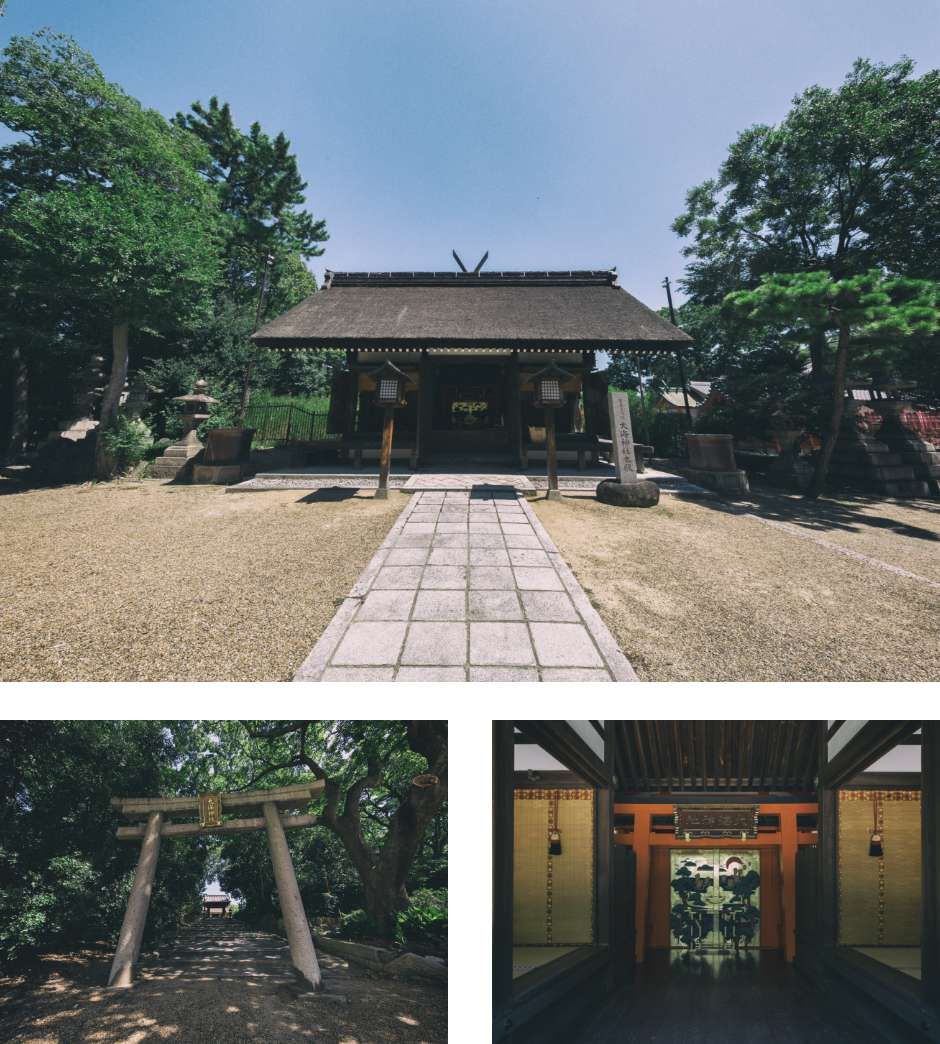
Daikai Jinja
Daikai Jinja is older than Sumiyoshi Taisha. It originally enshrined Watatsumi, a powerful god of the sea who provided spiritual protection for mariners on their voyages.
When empress-regent Jingū ordered the construction of Sumiyoshi Taisha in the third century, she asked the head priest of Daikai Jinja, Tamomi no Sukune, to lead the project. According to the second oldest book of Japanese history, the Nihon shoki (720), Tamomi no Sukune was descended from Ninigi no Kami, the god who is believed to be the ancestor of the emperors of Japan.
Tamomi no Sukune put two of his sons in charge of creating the new shrine. They received the surname Tsumori (literally, “port protector”), and their descendants would head Sumiyoshi Taisha until the religious reforms of the Meiji era (1868–1912).
Daikai Jinja is built in the same style as the main shrines of Sumiyoshi Taisha. It has a simple, straight-lined gable roof topped at each end by a pair of crossed timbers. The building’s columns are painted vermillion, and the exterior walls are white. The entrance faces west toward the sea, and the building itself is divided into two spaces: an outer room and an inner sanctuary.
The two deities currently worshipped at Daikai Jinja—Toyotamahiko no Mikoto and Toyotamahime no Mikoto—are both associated with the sea and maritime protection.
Stone Stage, South Gate, and Musicians’ Galleries
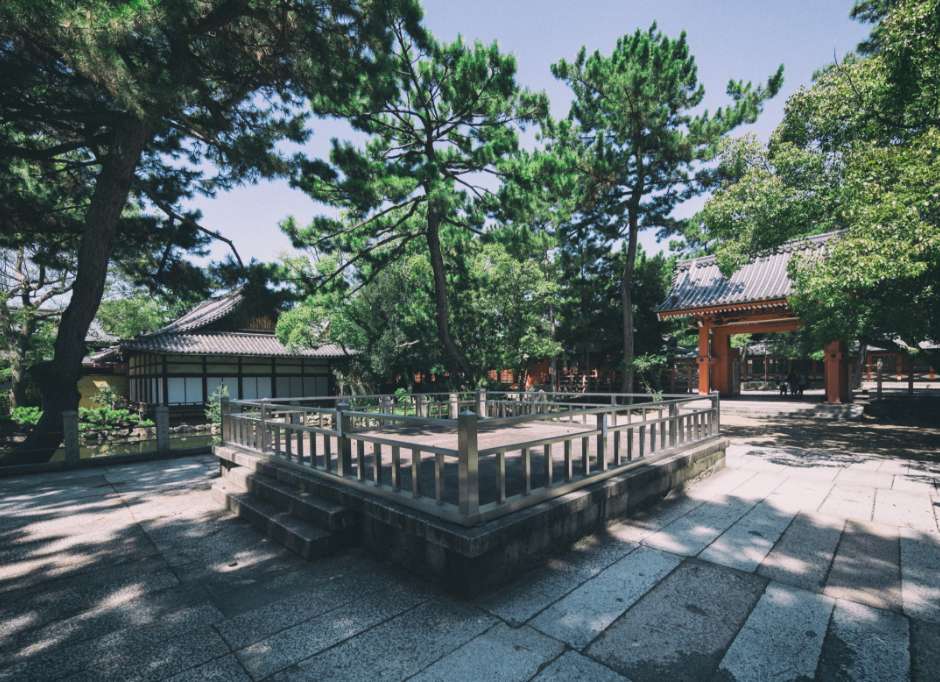
Stone Stage, South Gate, and Musicians’ Galleries
Many of the festivals and ceremonies at Sumiyoshi Taisha include kagura and gagaku performances. Kagura is an ancient religious dance and gagaku is the music that accompanies it. At Sumiyoshi Taisha, these performances are staged in the area directly between the four main shrines and the South Gate.
In the center is a stone stage that faces north toward the four shrines. It was built in 1607 to replace a wooden stage at the request of Toyotomi Hideyori (1593–1615), whose father Toyotomi Hideyoshi (1537–1598) ruled Japan at the end of the sixteenth century. Hideyori’s mother, Yododono (1567–1615), is said to have donated the Sorihashi Bridge at the western entrance to the shrine.
On performance days, a vermillion fence is placed along the edge of the stage, and the two galleries located on either side of the south gate are opened for musicians who perform inside. Two large taiko drums are set up near the galleries. As they perform, the musicians and kagura dancers face the main shrines, toward the gods of Sumiyoshi Taisha, rather than toward the crowds who gather to watch them.
The ports near Sumiyoshi Taisha were once the center of international trade in Japan, and the development of kagura and gagaku was influenced by the musical traditions brought by sailors and visitors from mainland Asia. This mixing of cultures influenced many parts of Japanese daily life and is one of the reasons why Sumiyoshi Taisha remains connected to the performing arts today, especially poetry and dance.
The stage, gate, and galleries are designated Important Cultural Properties.
Onda (Sacred Rice Paddy)
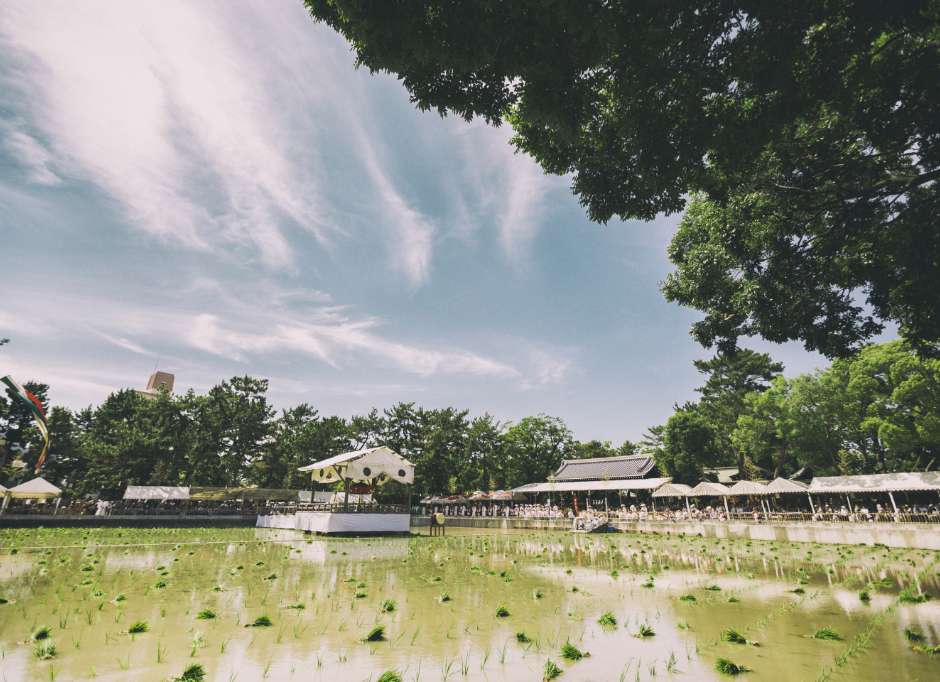
Onda (Sacred Rice Paddy)
The rice paddy just south of the shrine grounds is said to have first been planted by the legendary empress-regent Jingū in the third century. The rice grown there is considered sacred and is offered to the deities enshrined at Sumiyoshi Taisha. The rice is also used in the Minori Mairi—a series of rites performed at the four subsidiary shrines to pray for success in business.
Onda is a rare outpost of agricultural Japan amid the metropolitan sprawl of Osaka. Even in the countryside, few rice fields are still tilled by oxen or planted by hand, but the tradition is preserved in the rituals performed at Sumiyoshi Taisha. Every year during the Otaue Shinji ceremony, sacred oxen are led through the paddy and women plant rice seedlings in its waters. The planters and visitors then look on as costumed singers and dancers perform for the gods.
Researchers have found a unique mix of plants in this paddy, including the grass hamahiegaeri (Polypogon fugax), which grows in salty soil—a reminder that Osaka Bay once extended to the shrine’s doorstep.
Asazawa-sha
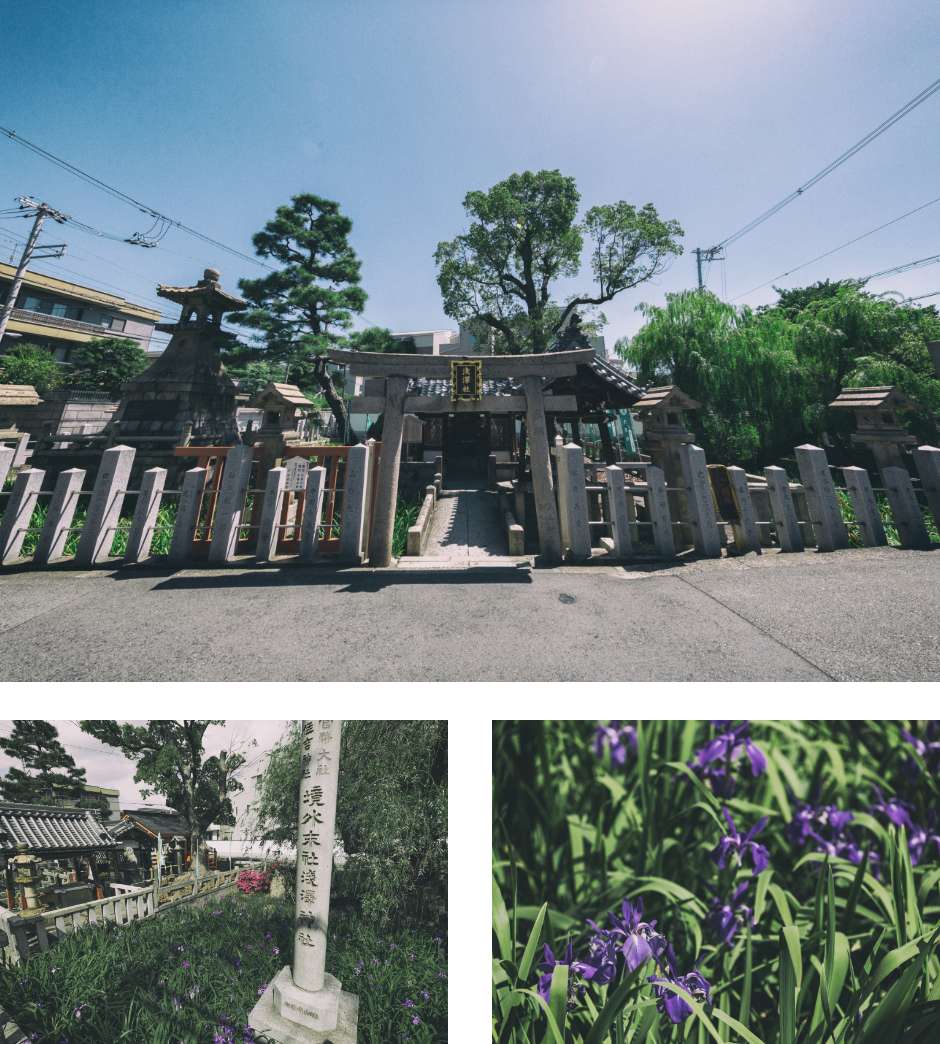
Asazawa-sha
Asazawa-sha is the third stop in the Hattatsu Mairi prosperity rite. This shrine is dedicated to the water goddess Ichikishimahime no Mikoto, a guardian deity of beauty and the performing arts. Ichikishimahime and the Buddhist goddess Benzaiten are often seen as being the same deity—an example of the centuries-long fusion of Shinto and Buddhism in Japan before the late 1800s. Today, Asazawa-sha is popular with women, especially actors, dancers, musicians, and other performing artists who are seeking to improve their skills and advance their careers.
Ōtoshi-sha
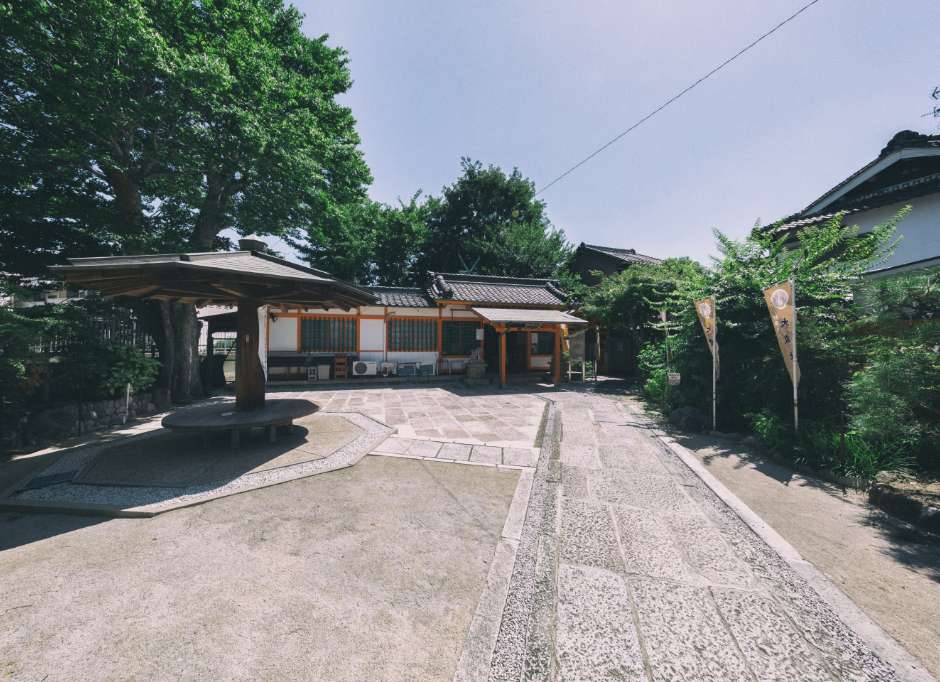
Ōtoshi-sha
Ōtoshi-sha is the last stop in the Hattatsu Mairi.
Hattatsu Mairi hours: 6:30 a.m. to 4:00 p.m.
Prayer donation: 1,000 yen
Ōtoshi-sha is associated with the rewards of working hard to create a business. Visitors performing the more complex Minori Mairi rite can exchange the sacred stalk of rice for a bag of white rice, which should be eaten on the day the rite is completed for maximum spiritual benefit.
Ōtoshi-sha is devoted to Ōtoshi no Kami, a Shinto harvest god and the older brother of Uka no Mitama no Mikoto, who is enshrined at Tanekashi-sha and Nankun-sha. One guidebook from the Edo period (1603–1867) says Osaka merchants would pray at this shrine when they were having trouble collecting the money owed to them.
Next to Ōtoshi-sha is a small shrine where visitors can use a set of stones called Omokaru-ishi to perform a ritual that tells whether their wishes will come true.







